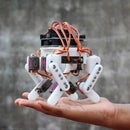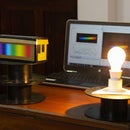Introduction: DIY Bucket Air Conditioner
I live in a rather hot place in the south of India and my work space gets stuffy. I found a neat solution to this problem by transforming an old bucket into a DIY air conditioner. The model of the AC is very simple, low cost but yet effective.
The basic idea to this project is: a fan that blows out air into a bucket of ice which results in a cool flow of air. We have added some cool features like smartphone control and a regulator to make the model more efficient.
Note: You will have to see the video to fully understand and appreciate the project.
If you like this instructable please vote for it at the top right corner of the page!
Step 1: Overview of the AC
How it works
We attached a brushless dc motor with a propeller inside the bucket. For air to get in we created a few openings at the top. We put a bucket of ice under the fan, so now when the air is pushed onto the ice the air gets cooled and escapes from three vents we have inserted on the side of the bucket. (look at the diagram to understand better)
Step 2: Parts Needed...
HARDWARE
- 2 buckets (1 small ,1 big)
- 12 " long and 2 " diameter PVC pipes (for the vents)
- 3 to 4 office wheels
- wood (for the support)
ELECTRONICS
- brusheless dc motor with 8 X 4.5" prop (a portable fan would do)
- esc of the motor
- arduino (any will do)
- lipo batteries (voltage and amperage according to the motor)
- jumper wires (pretty obvious)
- servo (strong enough to move the load of the bucket)
- an hc-05 bluetooth module
- a power indication led
- potentiometer (for speed control)
TOOLS
- a drill
- an x-acto knife
- soldering iron
- file
HANDWARE
- couple of skilled hands :)
Total estimated cost: 15 - 25 $
Step 3: Making the Body (openings)
Start by flipping the bucket. Place the motor at the center and make a circle of radius double the motor's diameter. Make 4 triangular cuts as shown in the second picture. Now with your x-acto knife cut out the colored part. Once done smoothen the edges with a file.
Please be careful while cutting. Blades are sharp!!!
Step 4: Making the Body (attaching the Motor)
Begin by placing the motor in the center and mark the holes out for the screws.Once done drill the holes (with drill bit of appropriate size). Screw on the motor from the inside and attach the propeller.
Step 5: Making the Body (inserting the Vents)
Cut the 12" pvc into three 4" pipes. Then mark the dimensions of the pipe onto the side of the bucket, make sure it is little higher than the mid-height of the bucket. Using a drill bit (the size of the pipe) drill out three holes each with 2 cms of gap in between. Insert the pipes into the holes you just made , if its slightly loose seal it using hot glue.
Tip: drill the holes slightly smaller than the actual diameter of the pipe and squeeze the pipe so that it holds tight, therefore you won't need to seal it.
Step 6: Making the Body (attaching the Wheels)
Take the office wheels and attach them onto the lid equally spaced out. Drill holes and screw the wheels on.
Congratulations!! You now have the basic body complete.
Step 7: VERSION 1 : on to the Electronics
Plug in the ESC to the motor, if you find that the propeller is reversed (blowing air from the openings) you will have to swap any two wires from the ESC to the motor. This should change the direction of the motor and blow air out the right way. To test the system hook up the ESC to a receiver (any will work) and control it through a transmitter. Now place your hand in front of the vents and see if there is a flow of air, if there isn't check for leaks.
The diagram will help you understand better.
Step 8: VERSION 2 : Using Arduino and Making a Speed Regulator
We used an arduino and a potentiometer to control the speed of the motor. The knob has five levels : slow, 2, 3, 4 and really fast. We also added a switch and a power indicator led to make the bucket look more complete. In the diagram above I have used a servo motor to show the actual brushless motor that we used, (as there was no esc and brushless motor in the software we used). The wiring is the same. Follow the diagram above. It is always a good practice to actually try the project on a breadboard. Attaching the knob to the bucket was simple we drilled a hole and passed the knob through from inside the bucket. The same way we also made a slot for the power switch.
The program for the arduino can be found attached below.
The video for activating the motor. Must watch.
Attachments
Step 9: VERSION 3 : Adding the Smart System (step 1)
Our final system will have a smartphone controller. To make that possible we have added a servo motor to make the body move. Start by attaching the servo horn (the plastic piece) to the top of the bucket and attach the servo to it. Once done make a holder for the servo so that it extends out and attaches to the ground.
Now run the system using the sweep program given here :
Attachments
Step 10: VERSION 3: Installing App / Bluetooth Setup(step 2)
Now for the bluetooth. First attach the bluetooth module (hc-05) to your arduino. As shown in the diagram above. Next install the android app from the link below which allows you to control a servo via your smartphone.
Link to the app : arduino servo controlling app
The app is very simple to use, all you have to do is turn on your system connect with the hc-05 bluetooth module (if you haven't paired the bluetooth module with your device earlier your device might ask you for a passkey which is usually 1234) and use the slider to control the angle of the servo.
The bluetooth control /servo code is given below.
Important : while uploading the code make sure to remove the tx and rx lines from the bluetooth module going to arduino.
Attachments
Step 11: Neatening Things Up
We didn't want wires on top of the whole system, so to make it look neat and tidy we made all the wires go inside the bucket and taped it to the interior walls. We kept the arduino outside to make it simple to access and connect to the computer. To get wires to the arduino we made a small slot and passed the wires through the slots (as seen in the 2nd picture). We stuck all the components to the top of the bucket with double sided tape
Step 12: Nearly There...
Now all you have to do is fill up a bucket with ice and put it inside the larger bucket under the fan.
Step 13: SIT BACK, AND ENJOY !!!
You have made the AC bucket now sit back and enjoy the cool breeze. We checked the temperature and we were getting readings of around 12 degrees centigrade, which is pretty impressive for a DIY AC bucket.
Hope you enjoyed the making of this project. If you have any questions we would be glad to answer them in the comments section.
:)

Runner Up in the
Bucket Challenge

Participated in the
Hack Your Day Contest














